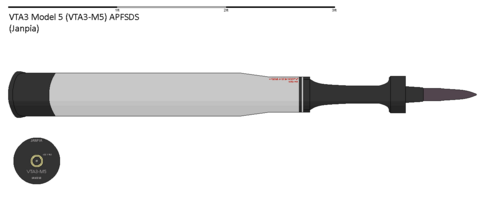VTA3-M5
| Vaskaroschi Tank Ammunition Category 3 - Model 5 (VTA3-M5) | |
|---|---|

 The insides and outsides of the VTA3-M5. | |
| Type | Tank Ammunition |
| Place of origin | Janpian Union |
| Service history | |
| Used by | Janpian Union |
| Production history | |
| Designer | Vaskaroschi Munitions Workers' Union - Ordnance Design Bureau |
| Designed | 2018 |
| Manufacturer | Vaskaroschi Munitions Workers' Union |
| Unit cost |
|
| Produced | 2020-present |
| Specifications | |
| Weight |
|
| Length |
|
| Diameter | 130mm (with casing) |
| Cartridge | 130x1300mm VTO |
| Caliber | 130x1300mm |
| Muzzle velocity | 2,859.87 m/s |
| Effective firing range | 3km+ |
The Vaskaroschi Tank Ammunition Category 3 - Model 5, also known as the VTA3-M5, is a high velocity armor-piercing fin-stabilized discarding sabot-tracer (APFSDS-T) round developed by the Vaskaroschi Munitions Workers' Union, specifically designed for the SAUT-130M5 smoothbore gun on the JP-2 tank. Although this round is capable for any 130mm smoothbore guns, the JP-2 seems to be the only tank in the Revolution's service that can fit the round into its storage. The JP-1 tank series was also put into consideration for the ammunition, but was phased out during the designing stages given that it was set for retirement from the Revolutionary Army. Regardless, the VTA3-M5 was first tested at Operation Fibonacci, where a JP-2 tank successfully penetrated more than 1,000mm rolled homogenous armor (RHA). It successfully penetrated it at a 0 degree penetration angle in a distance of 1.2 kilometers. All of which was done in a test-control environment.
History
Based on the combat exercises and theoretics from JURA, it was noted that their VTA3-M3 rounds were ineffective against their newer DU-coated composite layered armor, prompting the Revolutionary Council into taking tremendous efforts to compensate for its lack of penetration. Among the fruits of these efforts was the wide-spread adoption of an AI database: the Rakata Battle Management System, which enabled Rakata-equipped tanks to automatically aim and shoot at the weakspots of enemy vehicles, reducing the need for updated armaments and bypassing the heavier armored parts. This feature identifies vulnerable points in enemy armor as determined by the the fire control system, which then automatically aims the gun at a possible penetration point. Although this feature was revolutionary for an FCS, it still required several seconds to identify, calculate, and adjust the aim corrections to make a proper shot. Furthermore, the AI auto-aim program was proven to be time-consuming during the heat of battle, with the database taking a considerable amount of time to recognize and aim at an enemy vehicle during its ballistics and round analysis. While this feature was partially solved throughout the years, mainly via improvements on the auto-aim program and newer APFSDS designs such as the VTA3-M4, the Vaskaroschi Munitions Workers' Union has finally developed a design that would close the strategic gap.
Performance & Design
Based on the test results from Operation Fibonacci, the ammunition's theoretical muzzle velocity performance was determined, confirming that it goes at around 2,859.87 meters per second in SAUT-130M5 gun length, and it was able to sustain such velocities throughout the initial 2 kilometer flight. The said muzzle velocity also confirms that it generated up to 20 MJ of muzzle energy, which enabled the sabot to propel at such velocities from an 11.45 kg RPD-380 propellant base. This muzzle energy is slightly higher than the previous VTA3-M4 round, which can only generate up to 12.1 MJ. Nonetheless, the VTA3-M5 was also noted to have up to 804.22MpA in chamber pressure, which is much more higher than the standard 400 to 600 MpA in usual APFSDS. Although the high MJ muzzle energy and chamber pressure can potentially increase barrel wear over time, this was compensated by the engineers of the Vaskaroschi Workers' Union, who designed an advanced combustible cartridge that lessens barrel wear and making the overall weight of 34.18 kg. Given its weight, it is highly advisable to utilize autoloaders when loading the ammunition to the breech for efficiency and effectiveness.
Ascertained by the workers of Vaskaroschi, the VTA3-M5 round has a perforation limit of up to 1326.1 mm of RHA at 2 kilometer at a 75 degree angle, which could potentially render any armored vehicles below it as obsolete in terms of protection. Furthermore, the penetration material could also be swapped between tungsten and DU, with the tungsten material being capable of penetrating up to 1014.9mm of RHA for 2 kilometers at 0 degree angle. The ammunition also uses an electric primer, which utilizes an insulated resistor that can be ignited when the firing pin receives an electric current signal. Once the firing pin receives an electric current, it contacts with the circuit, which heats the resistors, allowing it to ignite the RPD-360 compound. This circuit can also be programmed for the BMS, which allows the ammunition to send data back to the digital screens, giving the crew the necessary information on what ammunition was loaded and fired from the breech. This could also be helpful for the AI aim-assist program, which takes the values of the APFSDS and calculates the necessary ballistics to determine and penetrate the weakspots of an identified enemy vehicle that is registered on the database.
As a standard from the JURA armory, all tank ammunition must have some tracer elements at the end of the ammunition. In the case of VTA3-M5, the tracer element is located between the fin-stabilizers, with the tracer color being modifiable on the factory output. As for the dimensions, the VTA3-M5 has a case diameter of 130mm which is enough to fit on to the breech of the SAUT-130M5, as well as an overall length of 1,312mm or 1.3 meters. Its main rod is mainly made out of depleted uranium, and it has an overall length of 956mm along with a diameter of 36mm. It also has penetrator cap length of around 150.29mm, along with a penetrator monoblock length of 146mm. This monoblock penetrator helps stabilize the yaw of the rod when it penetrates through Explosive Reactive Armor or angled armor, making it capable of penetrating even the latest generations of ERA. The VTA3-M5 is also rated to be effective at −32 to 63 °C, making it operational in any theaters or climates.
See also

